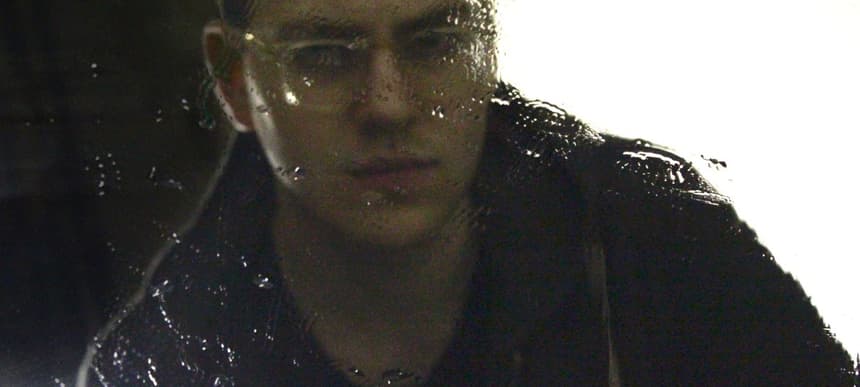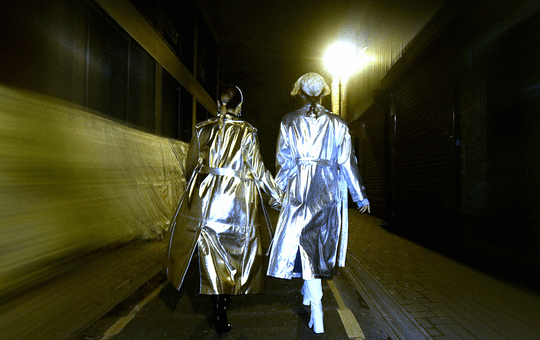
CFCF interview: "Evocative rather than provocative."
Midway through my conversation with Mike Silver, the Montréal musician who records as CFCF, I note how often his music is pigeonholed. “blog house, Balearic disco, chillwave, whatever 'night bus' is…” I start. He emphatically nods in agreement. Few artists have weathered the years since the music blog boom (his earliest releases, mostly bootleg remixes, appeared online around 2006) with their integrity intact; but Silver’s music has never neatly fit into any of these categories.
We’re on the terrace of a café equidistant from our respective houses in Montréal’s Mile End neighborhood. We arrived at exactly the same time, coming from perpendicular corners. It's an unseasonably cold evening in early September, and in preparation I've rewatched Wim Wenders’s documentary on the Japanese fashion designer Yohji Yamamoto, Notebook on Cities and Clothes, which I read was an influence on some of Silver's recent work. I ask him a lot of questions about Wenders. The talk circles back on itself several times.
My comment about those fleeting half-genres (well, other than Balearic disco) was only made in passing. Silver is a conservative; if my interview had a thesis, it certainly wasn’t to imply that he slavishly follows the trends. 'Outside', his new album, references 80s mainstays like Peter Gabriel, and its soaring apex is a cover, of Bonnie ‘Prince’ Billy’s Strange Form of Life. In production since 2009, it features a carefully selected list of guest musicians, and goes “above the water” in terms of properly crediting the players. He even had to rewrite a choral part on The Breath after Geinoh Yamashirogumi, the Japanese vocal group, refused to clear his sample. As a complete listen, it didn’t sound out of place as I wandered around an adjacent upper-middle class suburb the night before. Silver is in his twenties, but youth’s recklessness is almost completely absent from his songs.
Perhaps accordingly, 'Outside' has a very methodical procession. “The sequencing has been how it is on the record for a long time,” Silver says. “I sequenced it right after the final song was written, and always knew that that would be how it was. It starts off very dark, and ends quite soft and and reserved and kind of at peace.” In the scope of the album, the producer calls Transcend, the eighth track, “a shifting, like a changing of context or a rebirth.”
That dark opener is Beyond Light, a track that might find its way into the soundtrack of some Valhalla Rising-type film, with its duelling guitars (sampled from the black metal band Twilight), thundering war drums, and staccato pan pipes all emitting cathedral-sized reverb. “I kind of knew it would be the first [track], because it’s so grandiose and so huge,” he says. Strange Form of Life, the Bonnie ‘Prince’ Billy cover that comes a few tracks later (and features Sleep ∞ Over’s Stefanie Franciotti on backing vocals), similarly amplifies the original’s fragile emotion—particularly its hook. “There’s a lot of stuff going on in it. I almost feel like it’s a bit too epic, like I went a bit too far,” Silver worries. “But I’m happy with it nonetheless.”
"There’s something about [Strange Form of Life] that I really liked, how it expressed the derelict parts of rural areas that were left to nature. Like backyards with debris in them covered in snow; forgotten and abandoned houses that have grown into the landscape.” – CFCF
It turns out 'The Letting Go', the record the song is taken from, was a key inspiration for 'Outside'. “That record really expresses something,” he attests. “It kind of creates this fantastical world that is dark and light at the same time; it has a really earthy quality. The songwriting is really great. It’s my favorite record by him. I was listening to a lot on trains and busses, looking at the landscape. It has this kind of wintry, forlorn quality, but is [also] at peace. There’s something about this song that I really liked, how it expressed the derelict parts of rural areas that were left to nature. Like backyards with debris in them covered in snow; forgotten and abandoned houses that have grown into the landscape.”
Silver composed some of 'Outside' on those very trains and busses (and airplanes, and in three different apartments), working on and off from a laptop before taking the tracks to a proper studio last summer. Other than Franciotti, he collaborated with Active Child and Johan Tuvesson (of Karl X Johan and Nicolas Makelberge) as guest vocalists. Accordingly, the arrangements are easily his most complex yet. “It was actually kind of daunting when I was writing them,” he remembers. “I was working on them in Logic, and it got to a point where there were so many tracks and so many effects that the DAW would crash every time I pressed play. I would have to work on it in 10 second fragments of audio. So it was nice to go into the studio with the stems and re-track everything, because it just meant a fresh approach."
In Notebook on Cities and Clothes, Wenders suggests that Yohji’s clothes satisfy a “classic characteristic”. Given how uncannily familiar some of his album’s hooks feel, I wonder if Silver has a similar ambition, and he confirms my suspicions: “That’s how I try to work. I try to write evocative melodies, rather than like, provocative melodies. I’m not trying to find new styles of melody—I think a lot of artists do that and it’s totally admirable, trying to work in ways that you don’t often hear. [But] it never really felt like what I wanted to do. When I try to do those kinds of things it feels forced—it’s a little bit of a comfort zone, but it’s a comfort zone that I can find new spaces in.”
His palette itself is familiar. “I was intentionally trying to use a lot of sounds that were in vogue in the mid- to late-80s. The album has a ton of samples from the Fairlight CMI synth,” he says. “The vocal synth, some of the mallets, and the pan flute have this warmth…it’s this weird digital sample, it’s so not of this world, but it’s also organic. Part of what ended up driving me was listening to Peter Gabriel records, where he was trying to express something super organic by using completely inorganic sounds, which is really interesting to me because it taps into a deeper element, rather than using Irish folk sounds or things that are more traditionally thought of as organic. The sounds of this synthesiser come closer to expressing actual, tangible elements of a forest setting or something like that.”
The natural setting of 'Outside' follows a pair of EPs, 'Exercises' and 'Music For Objects', which abstractly deal with architecture and material goods, respectively. Both offer reductions of his more typically song-based approach, and emphasise improvisation and informal takes. “That’s probably why a lot of the tracks are under two minutes,” he remarks. “There’s one track on 'Exercises'—there’s no MIDI on that track, it’s just me playing my DX7 live. At the time I didn’t have a MIDI setup, so I just did three tracks of live recording, right into the computer.” By removing the songwriter aspect of his approach, Silver attempts to better translate imposing brutalist architecture, or a set of keys upon a kitchen counter.
“A lot of people think the things that will give your life meaning are those grand, giant emotions, like you’re terrified, or you’re in love, but what the EPs are trying to do is fill in the gaps between." – CFCF
But why channel such mundanity? “A lot of people think the things that will give your life meaning are those grand, giant emotions, like you’re terrified, or you’re in love, but what the EPs are trying to do is fill in the gaps between [those moments],” Silver explains. As with 'Outside', these pieces are imbued with emotional distance; the producer is never close enough to divulge anything personal, but they aren’t devoid of humanity either. Maybe this is because they aren’t studies as much as they are reflections. “[On 'Music For Objects'] I was thinking about objects separate…going back to Wim Wenders, he’s used this a lot in, say, Wings of Desire, and [also] he has this photo book…it’ll be something like a jacket strewn across the back of a chair, something that expresses that people have been there…it has a quality in and of itself. Or a half-finished cup of coffee or cigarette that’s lingering, that’s still smoking, and there’s no one around.” 'Exercises' similarly plays on nostalgia: “I was thinking about the time when I was in school, and more in transit around the city, through the metro stations, and having to go to the library or a government building to do this or that,” he says. “How your memory of it is completely different from your experience of it. It’s a nostalgia thing, and that can be dangerous because you’re ascribing a lot of meaning to times that were not super meaningful, but I think it’s valuable to try to express [anyway]. It’s interesting to give those places some sort of meaning, instead of just a place that you hate going to.” In both cases it’s the retrospective view that provides the color.
In Notebook for Cities and Clothes, Wim Wenders remarks on memory being woven into objects. It seems these “small, minute emotions,” the wisps of past and future action implied by static objects and architecture, are what lately drive Silver, if sometimes subconsciously. “When I have been doing interviews, I’ve thought about [my music] in terms of place and trying to express place, but it’s funny to have that context also. I’ve never really thought about it, that it’s also about memory, it’s about those two things interacting.” Perhaps part of what separates him from nostalgia-driven trends like chillwave is his interpretation of memory: “There’s more to nostalgia than looking at the past in that kind of longing way than just a really good summer that happened or something. There’s a lot of things it could bring up…nostalgia for shitty times, nostalgia for times that you haven’t had, nostalgia for absolutely terrifying things that you would never want to experience.”
In spite of the album’s grand scale, the preceding EPs’ subdued intimacy is always present. It’s telling when Silver compares his process to that of a filmmaker. “[The album] could be personal, but, for one thing, it’s trying to build a world,” he says of the record. “Every song is generally about something, but it’s not really anything that I went through, or any specific events that I went through. It’s kind of more trying to express more universal themes that are compelling to me.” The music might crash computers, but Silver’s on-record persona is transitory. “It’s not really coming from the core,” he says. It’s probably this distance, and its potential for malleability, that keeps lumping the producer in with the hype. This may not change with 'Outside'. Listeners will try to bend its vague landscapes to suit themselves. I mistook the sample of an Indonesian rainforest on Find to be something field-recorded closer to home (there are monkeys in the background, how could I have missed them?). Silver draws on familiar motifs, but he does not spell much out.
Dummy/Paper Bag released 'Outside' digitally on the 21st October (buy it here) and will release it physically on the 18th November (pre-order it here).














